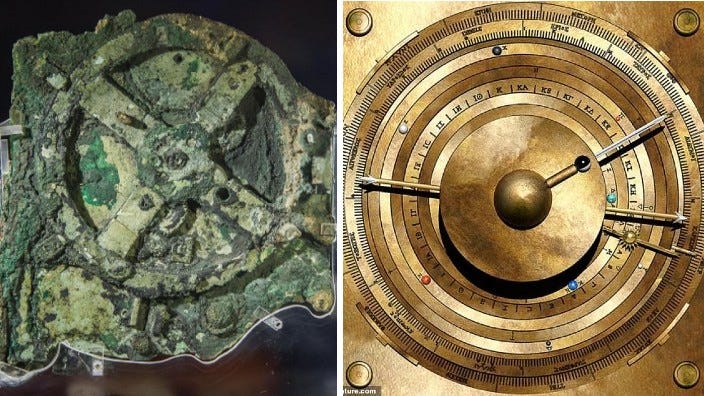⚙️ The Antikythera Mechanism: The World's First Computer
A discovery that would forever change our understanding of ancient technology
In 1901, a group of sponge divers exploring a shipwreck off the Greek island of Antikythera made a discovery that would forever change our understanding of ancient technology.
Amidst the bronze and marble statues, jewellery, and pottery, one object stood out for its sheer uniqueness: a corroded bronze device about the size of a shoebox, covered in gears and dials. Unbeknownst to the divers, this mysterious contraption would rewrite the history of ancient engineering and challenge our perceptions of the past.
⚙️ A Mechanical Marvel
The device, now known as the Antikythera Mechanism, quickly became one of the most captivating and enigmatic artefacts in archaeological history. Decades of research, X-rays, and CT scans revealed that this ancient "computer" was an astonishingly sophisticated machine used to calculate astronomical positions and predict celestial events like eclipses, moon phases, and festivals.
📖 The shipwreck housing the mechanism was dated to around 60 BCE, but some experts believe the device itself may have been created as early as 205 BCE, based on the astronomical events it appears to predict.
The Antikythera Mechanism featured at least 30 bronze gears arranged in a compact, multi-layered design that was centuries ahead of its time. Its intricacy and ingenuity were unparalleled, and nothing like it would be seen again for over a thousand years.
🌌 A Celestial Guide
The Antikythera Mechanism functioned as a sort of ancient planetarium, allowing users to input a date and see the positions of the sun, moon, and five known planets on that day. It also featured a dial displaying the moon's phases and a small sphere that mimicked the moon's elliptical orbit around Earth.
In addition to its astronomical functions, the mechanism included a calendar of athletic events like the Olympics, making it a versatile tool for tracking both celestial and terrestrial events.
The discovery of the Antikythera Mechanism revolutionised our understanding of ancient Greek technology, suggesting that the Greeks' grasp of astronomy, mathematics, and engineering was far more advanced than previously thought.
🏛️ Rewriting History
The discovery of the Antikythera Mechanism upended the conventional wisdom about ancient technology. Before its discovery, historians believed that this level of mechanical complexity didn't exist until the 14th century CE, with the advent of astronomical clocks in Europe. The idea that ancient Greeks could have created such a sophisticated device seemed almost impossible.
(Reconstruction below)
📖 The mechanism's existence suggests that the ancient Greeks had a much more advanced understanding of astronomy and mathematics than previously thought, and that they were capable of creating incredibly intricate mechanical devices.
Despite its clear importance, the exact origins of the Antikythera Mechanism remain a mystery. Some scholars speculate that it may have been created by a school of astronomers and engineers led by the brilliant inventor Archimedes in Syracuse.
🔍 Unlocking Ancient Secrets
Deciphering the workings of the Antikythera Mechanism was a monumental task, requiring the expertise of an international team of researchers. Advanced imaging techniques and 3D X-ray scans allowed them to map out the device's intricate gear trains and decipher the inscriptions on its surface, revealing a masterpiece of ancient engineering.
Today, the Antikythera Mechanism is widely recognised as the world's first analogue computer, its design principles echoing in everything from mechanical watches to modern-day planetariums. Its discovery has prompted a re-evaluation of ancient technology and sparked a renewed interest in the scientific achievements of the past.
📖 The mechanism's complexity and craftsmanship continue to inspire and mystify researchers, who are still unravelling the secrets of this ancient computer.
As we marvel at the technological wonders of the 21st century, it's humbling to remember that the ancient Greeks were already pushing the boundaries of what was possible over 2,000 years ago. The Antikythera Mechanism serves as a reminder that the pursuit of knowledge and the drive to understand the world around us are timeless human endeavours.
The Antikythera Mechanism is a testament to the enduring human spirit of curiosity, innovation, and the quest to comprehend the universe we inhabit.




